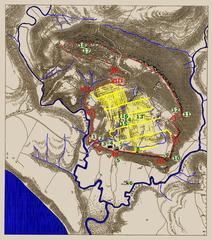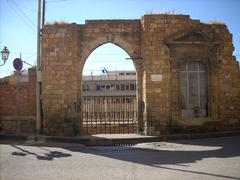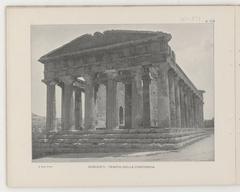Santa Rosalia Agrigento Visiting Hours, Tickets, and Historical Sites Guide
Date: 14/06/2025
Introduction to Santa Rosalia in Agrigento: History and Cultural Significance
Santa Rosalia, affectionately known as “La Santuzza,” is one of Sicily’s most cherished saints, embodying a legacy that has shaped the island’s spiritual and cultural identity for centuries. Born as Rosalia Sinibaldi in the 12th century, she is renowned for her noble origins and her remarkable choice to lead a life of solitude and devotion in the forests of Monte Quisquina, near Agrigento. Her retreat eventually gave rise to the Hermitage of Santa Rosalia alla Quisquina, a site still revered by pilgrims and travelers seeking to connect with Sicily’s religious heritage.
Santa Rosalia’s influence permeates Agrigento through sacred sites, annual festivals, and the famed Itinerarium Rosaliae—a pilgrimage route linking Agrigento to Palermo. These manifestations of devotion are woven into the local culture, celebrated through art, music, and community traditions that offer visitors an intimate glimpse into Sicilian identity and faith.
This comprehensive guide synthesizes authoritative sources to provide detailed information on visiting hours, ticketing, accessibility, and travel tips for those planning a journey to Santa Rosalia’s sites in Agrigento. Whether you are a pilgrim, history enthusiast, or cultural traveler, this resource ensures you can fully appreciate the saint’s enduring legacy (Catholic Family News, Vocidicittà, Itinerarium Rosaliae).
Table of Contents
- Origins and Early Life of Santa Rosalia
- Santa Rosalia’s Connection to Agrigento: Key Historical Sites
- Visiting Santa Rosalia Sites: Hours, Tickets, and Access
- The Discovery of the Cave and the Spread of the Cult
- The Itinerarium Rosaliae: Pilgrimage Route
- Artistic and Cultural Heritage
- Santa Rosalia in Contemporary Agrigento
- Festa di Santa Rosalia in Agrigento: Festival Guide
- Visiting Eremo di Santa Rosalia alla Quisquina: Practical Guide
- Frequently Asked Questions (FAQs)
- Plan Your Visit and Stay Connected
Discover Santa Rosalia in Agrigento: Visitor’s Guide
Origins and Early Life of Santa Rosalia
Rosalia Sinibaldi, born between 1125 and 1130 in Palermo, was the daughter of Duke Sinibaldo, lord of Quisquina and Monte delle Rose (present-day Agrigento province) (Catholic Family News). Her lineage linked her to Charlemagne and the Norman royal family (Sicily Uncovered). Rejecting the expectations of her noble birth, she chose a hermit’s life in the forests of Quisquina, living in a cave for about twelve years. This period of asceticism is central to her veneration in Agrigento (Vocidicittà).
Santa Rosalia’s Connection to Agrigento: Key Historical Sites
The Hermitage of Santa Rosalia alla Quisquina is the focal point of her veneration in Agrigento, built around the cave where she lived. Over time, the site expanded under the patronage of the Baroni Ventimiglia and local nobility, becoming a pilgrimage destination (Vocidicittà). The Diocesan Museum of Agrigento further preserves her legacy, displaying a 17th-century reliquary bust and other artifacts (Museo Diocesano AG).
Visiting Santa Rosalia Sites: Hours, Tickets, and Access
Hermitage of Santa Rosalia (Eremo di Santa Rosalia) - Quisquina
- Hours: Open daily, 9:00 AM–6:00 PM (last admission 5:30 PM). Hours may shift during festivals—verify locally.
- Tickets: Free entry; donations are appreciated.
- Accessibility: Moderate hike required; limited for visitors with mobility challenges.
- Guided Tours: Available on weekends and by appointment.
Diocesan Museum of Agrigento
- Hours: Tuesday–Sunday, 10:00 AM–5:00 PM.
- Tickets: €5 (general), €3 (reduced), free for children under 12.
- Highlights: Includes the reliquary bust of Santa Rosalia.
The Discovery of the Cave and the Spread of the Cult
In 1624, Santa Rosalia’s relics were discovered on Monte Pellegrino in Palermo, sparking renewed veneration. Soon after, an inscription confirming her hermitage was found in Quisquina, leading to the construction of a chapel and the region’s elevation as a center of devotion. The 400th anniversary in 2024 featured exhibitions of archival documents and relics (Malgrado Tutto Web).
The Itinerarium Rosaliae: Pilgrimage Route
The “Itinerarium Rosaliae,” established in 2015, is a 180-kilometer pilgrimage route connecting Quisquina’s hermitage with the sanctuary atop Monte Pellegrino in Palermo (Itinerarium Rosaliae). Traversing natural landscapes and historic villages, this trail offers a unique spiritual and cultural journey through Sicily.
Artistic and Cultural Heritage
Religious art dedicated to Santa Rosalia flourishes in Agrigento. The Diocesan Museum and local churches house paintings, sculptures, and silverwork that reflect centuries of devotion (Museo Diocesano AG).
Santa Rosalia in Contemporary Agrigento
Santa Rosalia continues to inspire festivals, processions, and restoration initiatives in Agrigento. Community participation remains strong, as seen during the 2024 exhibition and ongoing celebrations (Malgrado Tutto Web).
Visiting the Hermitage of Santa Rosalia alla Quisquina: Hours, Tickets, and Cultural Significance
Situated at 986 meters above sea level within dense forests, the Hermitage of Santa Rosalia alla Quisquina is both a spiritual and architectural marvel. Key features include:
- The Cave: Santa Rosalia’s original refuge.
- The Church: Reflects the simplicity of her ascetic life.
- Monastic Areas: Cells, kitchen, workshops, and crypt.
Pilgrimage to the site gained momentum after the 1624 relic discovery, with expansions funded by benefactors like Francesco Scassi. By the 18th century, it was a prominent destination for Sicilian pilgrims.
Visiting Hours and Tickets
- Hours: Typically open 9:00 AM–6:00 PM year-round; confirm before visiting.
- Tickets: Free entry; donations welcome. Guided tours may require a small fee.
Getting There
Located about 70 km northeast of Agrigento, the site is most easily accessed by car. Parking is available; taxis or shuttle tours can be arranged from nearby towns.
The Itinerarium Rosaliae
The pilgrimage route links the hermitage with Palermo’s sanctuary, passing through 15 municipalities and offering a mix of scenic and spiritual experiences (Itinerarium Rosaliae).
Visitor Experience and Tips
- Dress: Modest attire required; sturdy shoes recommended.
- Accessibility: Some areas are challenging for those with mobility issues.
- Special Events: Feasts on July 15 and September 4, with masses and processions.
- Local Cuisine: Try cheeses, cured meats, and almond desserts in nearby Santo Stefano Quisquina.
Festa di Santa Rosalia in Agrigento: Festival Guide
Historical and Cultural Significance
While Palermo hosts grand July celebrations, Agrigento’s festival emphasizes Rosalia’s hermitic years at Quisquina. The hermitage and the Chiesa Madre in Santo Stefano Quisquina are focal points of devotion (Itinerarium Rosaliae, Visit Santo Stefano Quisquina).
Festival Dates, Rituals, and Processions
- Date: First Sunday of June.
- Procession: The silver bust of the saint is paraded through the streets in a solemn procession accompanied by prayers and hymns (Enjoy Sicilia).
- Holy Mass, Blessings, and Offerings are integral parts of the program.
Community Traditions and Folklore
- Cavalcata: Horseback parade celebrating the saint’s protective journey.
- Communal Feasts: Lamb-based meals reflecting local pastoral culture.
- Music, Games, and Raffles: Community entertainment and charity events.
Visitor Tips and Accessibility
- Best Time to Visit: Arrive a day early for the full festival program.
- Access: Car recommended; limited public transport.
- Hermitage Hours: October–June (weekends), 9:30–12:30 & 15:00–18:00; July–September (daily), 9:30–13:00 & 16:00–19:00.
- Guided Tours: €3 per person, available onsite.
- Dress and Etiquette: Modest dress; respect local customs.
Accommodations and Cuisine
- Where to Stay: Agriturismi and guesthouses in Santo Stefano Quisquina—book early for festivals.
- What to Eat: Sample lamb dishes, local cheeses, and Sicilian sweets.
Visiting Eremo di Santa Rosalia alla Quisquina: Practical Guide
Access and Transportation
- By Car: About 1.5 hours (60 km) from Agrigento; best option for flexibility.
- By Public Transport: Limited bus service; taxis or private transfers should be pre-arranged.
- Parking: Free, but fills quickly during festivals.
Facilities and Local Culture
- Amenities: Restrooms, visitor center, small shop for souvenirs and local products.
- Food: No permanent cafés, but food stalls during festivals; bring water and snacks.
- Guided Tours: Available in Italian and sometimes English; book in advance.
- Accessibility: Paved paths, but cave and some areas require stairs or uneven terrain.
Local Traditions
- Annual Celebrations: July 10–15, with processions, open-air masses, and craft markets.
- Pilgrimage: Vibrant during feast days, with walkers and community events.
- Local Cuisine: Almond and pistachio sweets, rustic breads, cheeses, and seasonal fruits.
Frequently Asked Questions (FAQs)
- When are the hermitage’s visiting hours? Daily, 9:00 AM–6:00 PM (check for variations during festivals).
- Is there an entry fee? Entry is free; donations are appreciated. Guided tours may require a small fee.
- Are guided tours available? Yes, in Italian and sometimes English.
- Is the hermitage accessible for wheelchairs? Partially; some areas are challenging.
- When is the best time to visit? Spring and autumn for mild weather; July for festivals.
Plan Your Visit and Stay Connected
Stay informed about Santa Rosalia sites, festival dates, and travel tips by downloading the Audiala app, which offers real-time updates, guided tours, and maps. For more insights into Sicilian heritage, explore related posts and follow us on social media.
Internal Links:
External Links:
Summary and Recommendations
Visiting Santa Rosalia’s sites in Agrigento offers a profound journey through Sicilian spirituality, history, and local culture. From the peaceful hermitage nestled in the Sicani Mountains to the vibrant traditions of the Festa di Santa Rosalia, each experience is marked by authenticity and community spirit. Plan ahead for visiting hours, guided tours, and accommodations—especially during festival periods. For personalized itineraries and up-to-date information, leverage digital resources and local visitor centers. Whether seeking spiritual reflection, cultural immersion, or historical discovery, Santa Rosalia’s legacy in Agrigento promises an unforgettable Sicilian adventure (Enjoy Sicilia, Visit Santo Stefano Quisquina).
References
- Catholic Family News
- Vocidicittà
- Enjoy Sicilia
- Itinerarium Rosaliae
- Visit Santo Stefano Quisquina
- Museo Diocesano AG
- Malgrado Tutto Web
- Sicily Uncovered - Saint Rosalia
Immerse yourself in the spiritual and cultural legacy of Santa Rosalia—plan your visit to Agrigento today!





